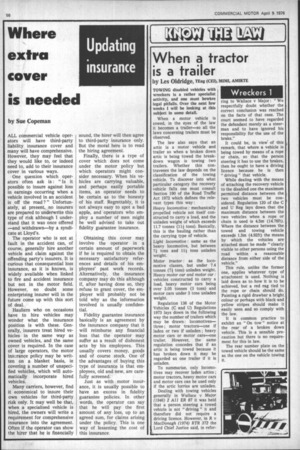When a tractor is a trailer
Page 58

If you've noticed an error in this article please click here to report it so we can fix it.
by Les Oldridge, TEng (CEO, MIMI, AMIRTE
TOWING disabled vehicles with wreckers is a rather specialist activity, and one must bew'are legal pitfalls. Over the next few weeks I will be looking at this subject in some detail.
When a motor vehicle is towed, in the eyes of the law it becomes a trailer—so all the laws concerning trailers must be observed.
The law also says that an artic is a motor vehicle and trailer so when a broken down artic is being towed the breakdown wagon is towing two trailers. Whether this contravenes the law depends on the classification of the towing vehicle. To discover into what particular category •the recovery vehicle falls one must consult Section 190 of the Road Traffic Act 1972 which defines the relevant types this way : Heavy locomotive : mechanically propelled vehicle not itself constructed to carry a load, and the unladen weight of which exceeds 11.7 tonnes (11i tons). Basically, this is the hauling rather than the carrying type of vehicle.
Light locomotive : same as the heavy locomotive, but between 71 tons and 113 tons unladen weight.
Motor tractor : as the locomotive classes, but under 7.4 tonnes (71 tons) unladen weight. Heavy motor car arid motor car : vehicles constructed to carry a load, heavy motor cars being over 3.05 tonnes (3 tons) and motor cars under 3 tons unladen weight.
Regulation 136 of the Motor Vehicles (C and U) Regulations 1973 lays down in the following way the number of trailers which may be drawn : locomotives— three: motor tractors—one if laden or two if unladen ; heavy motor cars or motor cars—one trailer. However, the same regulation concedes that if an artic is being towed because it has broken down it may be regarded as one trailer if it is unladen.
To summarise, only locomotives may recover laden artics ; motor tractors, heavy motor cars and motor cars can be used only if the •artic lorries are unladen.
Dealing with towing vehicles generally in Wallace v Major (1946) 2 All ER 87 it was held that a person steering a towed vehicle is not " driving " it and therefore did not require a driving licence. However, in R v MacDonagh (1974) RTR 372 the Lord Chief Justice said, in refer
ring to Wallace v Major : "We respectfully doubt whether the correct conclusion was reached on the facts of that case. The court seemed to have regarded the defendant merely as a steerman and to have ignored his responsibility for the use of the brake."
It could be, in view of this remark, that where a vehicle is being towed by means of a rope or chain, so that the person steering it has to use the brakes, then he ought to have a driving licence because he is then " driving " that vehicle.
While dealing with the means of attaching the recovery vehicle to the disabled one the maximum permitted distance between the two vehicles must be considered. Regulation 120 of the C and U Reg lays down that the maximum distance between the two vehicles when a rope or chain is used is 4.5m (14.76ft). Where the distance between the towed and towing vehicle exceeds 1.5m (4.92ft) the means by which the vehicles are attached must be made " clearly visible to other persons using the road within a reasonable distance from either side of the vehicle."
This rule, unlike the former one, applies whatever type of attachment is used, Nothing is laid down as to how it is to be achieved, but a red rag tied to the rope or chain should do. Painting a rigid drawbar a bright colour or perhaps with black and yellow stripes should make it easily seen and so comply with the law.
It is common practice to exhibit an "On tow" notice at the rear of a broken down vehicle. This is a sensible precaution but there is no requirement for this in law.
The rear number plate on the towed vehicle should be the same as the one on the vehicle towing it




























































































































